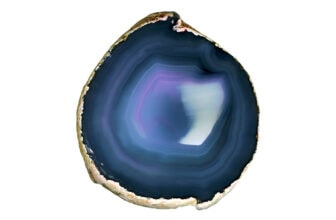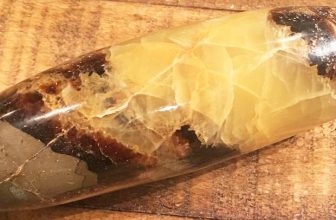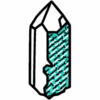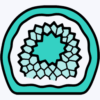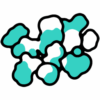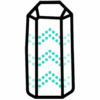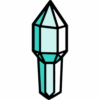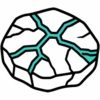Concretions
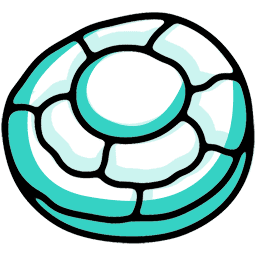 Sculpted by Time, Bound by Earth
Sculpted by Time, Bound by Earth
Imagine uncovering a smooth, perfectly rounded stone in the middle of a windswept field – its surface weathered yet strangely deliberate, as though some unseen artisan carved it by hand. You turn it over, feeling its weight, its symmetry, and you can’t help but wonder: how did nature craft something so intentional without tools or design?
These are concretions – natural sculptures formed not by human effort but by the quiet persistence of minerals moving through time. Within layers of sedimentary rock, mineral-rich water seeps, flows, and deposits. Over countless years, it cements particles together around a tiny seed – a fragment of shell, a leaf, a grain of sand. Slowly, patiently, a stone takes shape.
While they can appear deceptively artificial, concretions are among Earth’s most authentic works of art. Their surfaces may gleam with iron-rich reds or shimmer with silvery pyrite. Some are smooth and near-perfectly spherical, while others form bulbous, organic masses that look alive.
Scientists study concretions because they preserve the history of mineral migration, fossilization, and geochemical change within ancient rock beds. Collectors, on the other hand, cherish them for their balance, symmetry, and quiet power – a tangible reminder that beauty can be born from pressure, patience, and elemental flow.
Concretions are both records and relics – pages in the stone-bound story of Earth’s evolution.
Nature’s Cementing Alchemy
At first glance, a concretion might seem solid and static, but its birth is a dynamic process – almost alchemical in nature. Picture layers of soft sediment resting beneath ancient seas or riverbeds. Through this porous material, mineral-charged water weaves its path, carrying dissolved elements like calcite, iron, or silica.
Then something subtle yet transformative occurs. A nucleus – perhaps a decaying plant fragment, a small fossil, or even a bubble of trapped organic matter – becomes a gathering point. Around this seed, minerals begin to crystallize, binding grains of sediment together like invisible glue.
Over centuries, this cementing process continues outward, creating a stone-within-stone structure. The surrounding sediment may remain soft for ages, but the concretion within becomes dense and unyielding – a mineral heart solidified long before the rock around it hardens.
Some concretions form perfect spheres, layered like onions with concentric rings of mineral deposits. Others radiate crystalline structures from their center, creating mesmerizing patterns visible when the stone is cut open. And some – particularly those rich in iron or pyrite – take on metallic lusters that gleam with otherworldly brilliance.
Types and Textures of Concretions
No two concretions tell the same story. Each one carries a fingerprint of its environment, a record of what the Earth was doing when it formed. Their diversity in color, shape, and mineral makeup feels almost infinite – as though nature were experimenting with design.
Some concretions are pale and chalky, their surfaces smooth as eggshells. These are often calcite concretions, common in limestone beds and ancient seabeds. Others feel dense and heavy, colored in deep ochres or reds – the ironstone concretions, rich in siderite, that seem to pulse with Earth’s metallic heart. And then there are the show-stoppers: pyrite concretions, with their shimmering gold tones, masquerading as treasure from another world.
Silica-based concretions tell a subtler story. Their surfaces may seem dull at first, but when polished or sliced open, they reveal translucent bands that resemble agate or chalcedony. Each ring marks a pause, a shift in chemistry – time rendered in stone.
Perhaps the most mesmerizing are septarian concretions. They appear cracked, divided by honeycomb-like lines filled with calcite or aragonite. It’s as if the Earth herself fractured them to reveal her inner geometry. When polished, their interiors resemble maps – glowing continents of gold and tan separated by veins of stone.
Concretions can be round, disc-like, elongated, or wildly irregular. Some grow in clusters that resemble coral or fruiting bodies. Others, when broken open, display tiny fossil remnants – leaves, shells, or bones suspended in time. Their colors shift with chemistry: iron oxides stain them in reds and browns, while organic residues gift them shades of gray or deep black.
Every concretion is an experiment in patience – proof that shape and meaning can emerge slowly, guided by nothing more than mineral flow and stillness.
From Stone to Spirit
Collectors, lapidaries, and crystal enthusiasts are drawn to concretions not just for their rarity, but for their personality. They bridge the space between geology and artistry – natural forms that seem designed with intention.
When polished, their internal structures come alive. Bands of mineral contrast and geometric divisions create mesmerizing visual depth. Many concretions are cut into halves or spheres, revealing intricate growth layers, fossil inclusions, or radiant crystalline centers.
In the crystal and gemstone world, septarian concretions are especially beloved. Their blend of grounding brown aragonite, bright yellow calcite, and dark gray limestone mirrors the balance between stability and creativity. They’re said to carry the energy of Earth’s renewal – transforming heaviness into harmony.
Pyrite concretions, with their metallic sheen, are admired for their energetic strength. They’re often placed in workspaces or meditation areas to amplify confidence and focus, echoing the mineral’s natural resilience.
Meanwhile, chalcedony and silica concretions appeal to those seeking clarity – both visual and mental. Their soft luster and translucence seem to invite reflection and calm.

